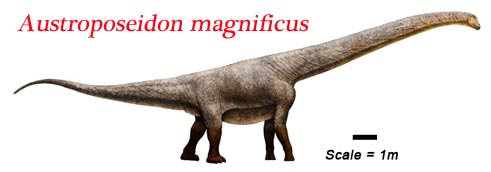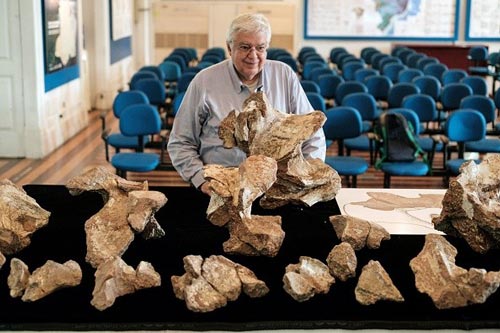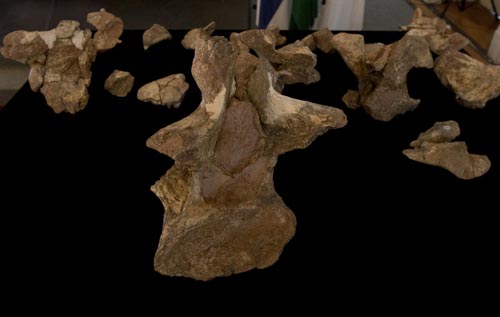Brazil’s Biggest Dinosaur To Date is Described in New Paper
Austroposeidon magnificus and Llewellyn Ivor Price
This week has seen the formal naming and scientific description of Austroposeidon magnificus, the largest dinosaur, indeed the largest terrestrial animal known to science to have ever lived in Brazil. Writing in the on line academic journal “PLoS One”, the researchers, which include Dr Alexander Kellner of the Federal University (Rio de Janeiro, Brazil) and the director of the Earth Sciences Museum, Diogenes de Almeida Campos, also based in Rio de Janeiro, announced the latest edition to the Titanosauria clade.
An Illustration of Austroposeidon magnificus a New Brazilian Dinosaur
Picture credit: Everything Dinosaur
Fossils Found in 1953
The fossil material which consists of two cervical vertebrae (neck bones), a fairly complete first dorsal vertebra and several other partial dorsal vertebrae with at least one sacral element was found by pioneering Brazilian palaeontologist Llewellyn Ivor Price in 1953. Sadly, Llewellyn Ivor Price died in 1980, although he made a major contribution to the advancement of geology and palaeontology in Brazil, these particular, giant fossilised bones and their significance was not recognised during his lifetime.
Ironically, the paper on this new herbivorous dinosaur “A New Giant Titanosauria (Dinosauria: Sauropoda) from the Late Cretaceous Bauru Group, Brazil”, was published in the same week of October that Llewellyn Ivor Price passed away. The paper being published on the 5th October 2016, the palaeontologist passing on the 9th October 1980.
Museum Director Diogenes de Almeida Campos with the Partial Backbone
Picture credit: Silvia Izquierdo/Associated Press
In numerous cases, fossils are stored for many years prior to their formal description. A lack of funds or indeed trained staff to examine fossils within a collection can mean that it can be decades before fossils are scientifically examined. In the 1950s, little was known about the Titanosauria clade compared to what we know today, although Titanosaurus, the dinosaur after which this clade was named, had been described back in the late nineteenth century (T. indicus 1877) – although most of the material associated with Titanosaurus indicus is regarded as nomen dubium (concerns raised over validity).
The Tenth Brazilian Titanosaur
With the naming of Austroposeidon magnificus, Brazil has a total of ten titanosaurs (we think), although based on these fossil remains A. magnificus is by far the largest, with the researchers estimating that it would have reached lengths of around twenty-five metres. The name of this new Late Cretaceous dinosaur reflects its impressive size, the name means “great, elevated, noble southern earthquake lizard”.
The fossils come from Upper Cretaceous strata of the Presidente Prudente Formation (Bauru Group, Paraná Basin), São Paulo State, south-eastern Brazil. This unit has also produced the fossilised remains of two other Brazilian titanosaurs, Brasilotitan nemophagus (which was named in 2013) and Gondwanatitan faustoi (named in 1999). Although Brasilotitan and Gondwanatitan are only known from fragmentary remains they are likely to have been considerably smaller than the newly described Austroposeidon.
Gregory S. Paul has estimated Gondwanatitan to have been around seven metres in length, whereas, Everything Dinosaur team members estimate Brasilotitan to have been slightly bigger perhaps as much as ten metres long. Prior to the naming of Austroposeidon, the largest titanosaur known from Brazil (we think), was Maxakalisaurus topai, fossils of which come from another member of the Late Cretaceous Bauru Group. Once estimated to be around thirteen metres long, in June 2016 a fossilised jaw bone and other cranial elements were ascribed to Maxakalisaurus and the size of this dinosaur was revised upwards to around twenty metres.
The Fossilised Fragmentary Vertebrae on Display
Picture credit: Silvia Izquierdo/Associated Press
Austroposeidon magnificus
The large bone in the centre of the picture is cervical vertebrae 13, the number represents the place in the neck that this bone was located. This bone shows some of the four autapomorphies (unique traits) that led to the identification of the new dinosaur genus. Cervical thirteen was one of the bones subjected to CT scans in order to reveal internal structures, the research team identified dense growth rings, a first for the Sauropoda. Austroposeidon shows that giant titanosaurs were present in Brazil during the Late Cretaceous, as well as further south in South America (Argentina).
Although the fossil material is very fragmentary, the scientists were able to undertake a phylogenetic analysis, in the Sauropoda the bones that make up the spine are highly diagnostic. The researchers concluded that Austroposeidon magnificus is nested within the Lognkosauria, a clade of titanosaurs that includes a number of super-sized genera. Based on this research, the authors of the paper conclude that this dinosaur was probably related to Puertasaurus, another enormous titanosaur that lived at approximately the same time as Austroposeidon, but its fossils are found further south.
Llewellyn Ivor Price may have died many years ago, but his fossil finding exploits are still helping to shape our understanding of Brazil’s prehistoric past.




